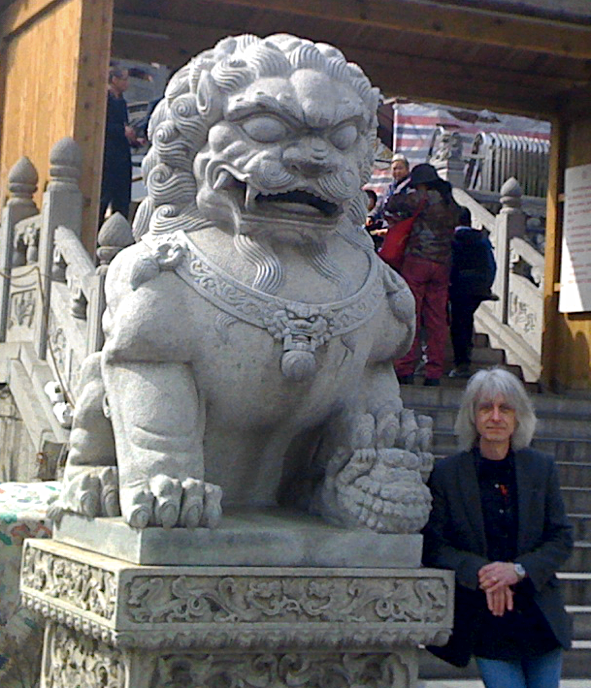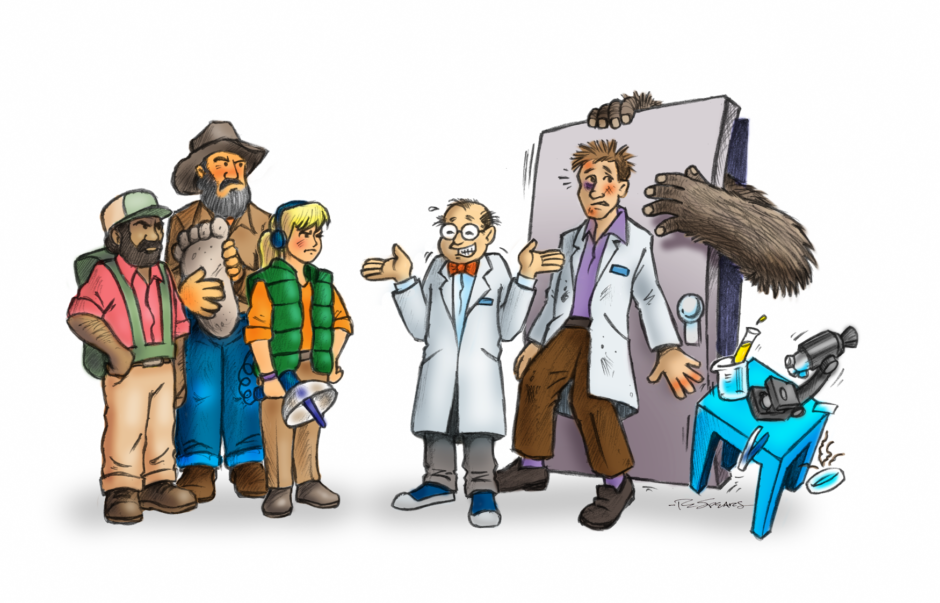A popular theory among some Bigfoot researchers or “Bigfooters” is that there’s a Sasquatch conspiracy afoot. They think the scientific community seeks to thwart Bigfoot’s discovery by ostracizing scientists who search for the creature and suppressing evidence of Bigfoot’s existence. Purported reasons for this range from petty feuds to ego to secret plans within the government.
But some scientists strongly disagree with this idea, including those who have faced the legendary subject of Sasquatch during their careers—and lived to tell the tale.
“I don’t think there’s any sort of conspiracy to disprove the existence of Bigfoot at all,” says geneticist Bryan Sykes, author of Bigfoot, Yeti, and the Last Neanderthal: A Geneticist’s Search for Modern Apemen. “It’s blatant paranoia or delusion to think that.”
In 2014, Sykes led a study where scientists asked people to send them hairs that they suspected were from cryptids (mythological animals) like Sasquatch. They received 57 hair samples and were able to sequence 30 of them. While most of the samples revealed known mammals, two samples revealed what appeared to be a previously unrecognized species of bear. The study’s findings were published in The Royal Society journal.
“There’s all the conspiracy theorists saying that scientists or the government are covering [Sasquatch] up,” Disotell says. “It doesn’t hold water.”
“The idea that the scientific community is actively conspiring to prevent Bigfoot evidence from ever reaching the popular attention is nonsense. Editors of top journals would jump at the chance to publish a paper [proving Bigfoot exists] if it ever materialized,” says Norman MacLeod, curator of paleontology at London’s Natural History Museum. Adding jokingly: “Probably walk over their mothers to publish it.”
Molecular primatologist and New York University professor Todd Disotell, who has been on TV programs like Ancient Aliens and 10 Million Dollar Bigfoot Bounty, agrees that there is no anti-Sasquatch plot.
“There’s all the conspiracy theorists saying that scientists or the government are covering [Sasquatch] up,” Disotell says. “It doesn’t hold water. No one’s career is going to end or be damaged if Bigfoot is discovered. I think the average scientist would be super excited. Primates went extinct in North America 30 million years ago. If you find out one didn’t… that’s cool!”
When discussing his 2014 cryptid study, Sykes says no other scientists or establishments stood in the way of him getting published because he did “proper scientific work, which was the best way to do it.”
“I have quite a lot of faith in the scientific peer review process,” Sykes says. “My paper was published in a good journal. It wasn’t held up at all by the peer review system.”
But not everyone shares this point of view.
In the past, scientists like Idaho State anatomy and anthropology professor Jeffrey Meldrum have had trouble getting pieces published in journals. This is because of bias against the subject of Bigfoot, Meldrum says, and a lack of open-mindedness among some scientists.
“We give [the peer review process] lip service, but you can find there are tons of criticisms of it,” Meldrum said in a Hot Alien interview earlier this year. “Everyone has had an experience where one or two people serve as gatekeepers and influence or determine whether knowledge is disseminated or aired for further discussion and commentary.”

There is a lot of criticism of peer review in science, and whether or not the process “works” is up for debate. Some question why certain studies get published over others, and even suggest that top journals are damaging to scientific inquiry.
But regardless of a possibly flawed review system, one reason that journals may not be interested in some Bigfoot-related studies is because the findings aren’t handled in an acceptable fashion.
In 2013, a press release was published claiming that scientists had sequenced Bigfoot DNA and confirmed “the existence of a novel hominin hybrid species,” but no data had been released to prove it.
The study was referred to as The Sasquatch Genome Project, and was led by Melba Ketchum, a veterinarian who operated a DNA testing company in Timpson, Texas.
Ketchum pushed a political call to action in the release, saying: “Government at all levels must recognize [bigfoot] as an indigenous people and immediately protect their human Constitutional rights against those who would see in their physical and cultural differences a ‘license’ to hunt, trap, or kill them.”
The release ended with the promise that “full details” would be “presented in the near future when the study manuscript publishes,” something that Sykes found notably unorthodox.
“If a young scientist told me that she was going to spend one third of her academic pursuit in the Pacific Northwest looking for Bigfoot, I would not recommend that to her,” Disotell says. “But if … somebody came to her and said, ‘Can you sequence this for me?’ I wouldn’t tell her to turn it down.”
“It was highly unusual for a professional scientist to release preliminary information about the outcome of a project intended for publication, except in confidence and for good reason,” Sykes writes in Bigfoot, Yeti, and the Last Neanderthal. “[If] the study was about to be published then any journal would be furious with this premature release of the content and would probably pull the article. Journals are naturally keen to make the most of the publicity generated by original articles, especially one as spectacular as this one promised to be.”
Ketchum’s project deviated so far from traditional scientific data handling that it was written off as a probable hoax by multiple scientists, and has not been proven legitimate since.
MacLeod agrees that scientific journals want to publish actual findings with provable data; they don’t publish “progress reports.” Thus, any incomplete information about Bigfoot or an untestable theory about the creature’s existence likely wouldn’t be seriously entertained by the scientific community.
Of course, MacLeod adds, you can publish a theoretical paper that doesn’t have empirical evidence to support it, but it would only be useful if it were a theory that other scientists could then go out and test themselves, like Albert Einstein’s general theory of relativity.
“If a paper is just pure theory that cannot be tested,” MacLeod says, “then people would look at that very hard and say: ‘Well, if we can’t test this theory, then what’s the point of proposing it?’”
In other words, any push-back against Bigfoot research may come from expectations surrounding standards of scientific integrity, which everyone is expected to adhere to.
While there may not be a grand, coordinated scheme to suppress Sasquatch evidence, some have witnessed flagrant bias, with some scientists insisting that Bigfoot doesn’t exist.
“I was faced with a colleague saying, ‘[Bigfoot] can’t exist; therefore, they don’t exist, and it doesn’t matter what evidence you think you have.’ And that’s a verbatim quote,” Meldrum said. “Where can you expect to get an equitable and objective review from an individual like that? They’ve already made up their mind.”
MacLeod says that just because certain scientists are biased, that doesn’t mean the field of science should be judged or vilified for it.
“Scientists have their own biases and prejudices and suppositions and assumptions, so you would not have to look very hard to find a reputable scientist that would say categorically that things like Bigfoot don’t exist. But that’s a personal statement for them; that is not a statement of science,” MacLeod says. “It’s not completely impossible that Bigfoot could exist, and any scientist who says anything is completely impossible isn’t thinking very hard.”
Because of this stigma, Disotell says, young scientists should be considerate about how much time and effort they lend to studying Bigfoot.
“If a young scientist told me that she was going to spend one third of her academic pursuit in the Pacific Northwest looking for Bigfoot, I would not recommend that to her,” Disotell says. “But if she ran a lab where they sequenced DNA and she works on numerous other taxa and stuff, and somebody came to her and said, ‘Can you sequence this for me?’ I wouldn’t tell her to turn it down.”

In his book, Sykes said that he was concerned he may be met with ridicule because of his interest in Bigfoot. But when a press release was sent out to draw attention to his 2014 cryptid study, the response was mostly positive.
Aside from an anthropology professor in St Louis, Missouri, who told the Associated Press that the study was “frivolous and futile,” Sykes writes that he was “pleased to see that there were very few comments about whether or not this was an appropriate subject for investigation by ‘serious’ scientists.’”
By the time he pursued the Bigfoot subject, however, he was established in his career, so there was less for him to lose.
“Most scientists, earlier in their careers where their advancement depends on what they do, would not investigate Bigfoot,” Sykes says. “I think it’s a choice. As a professional scientist you have to think carefully about what project you investigate. But now I’m at the end of my career, so whatever happens to me is irrelevant as far as advancement goes.”
Disotell says his friends will sometimes joke around with him about his Bigfoot involvement while out at a bar, and they may say Bigfoot is bunk, but never that he’s bunk.
None of his associations with Sasquatch or other strange things has threatened or even dampened his career, Disotell says. As far as he can tell, the deans and administration love that he’s on TV shows sounding smart with “NYU” on the screen crawl.
“[Bigfoot researchers] don’t want to pay and that tells me they don’t believe in Bigfoot either,” Sykes says. “Because if they did, they would be willing to mortgage their house to find Bigfoot—but they don’t do that.”
Not everyone is so lucky.
Meldrum, for example, has endured quite a backlash, ranging from public aspersions cast by his peers to an Idaho legislator attempting to have his tenure revoked. Disotell, who says Meldrum is a good scientist, stood up for the Idaho State prof when interviewed for a 2007 article in Scientific American, calling Meldrum’s treatment by other scientists “a shame.”
Washington State anthropologist Grover Krantz—known as the first scientist to dedicate his career to the search for Sasquatch—also endured scorn, having been turned down for promotions and publicly attacked by his peers.
One possible difference between Disotell and Meldrum’s involvement with Bigfoot, Disotell says, is that Meldrum has “gone all in,” dedicating much more of his career and focus to the search, which makes him an easier target for ridicule. Meanwhile, scientists like MacLeod, Sykes and Disotell distance themselves from close association, saying adamantly and repeatedly that they do not consider themselves to be Bigfoot scientists or researchers merely because they’ve done tests or commented on the creature’s existence in academic settings.
That said, Sykes and Disotell are often sent samples to analyze, and they both say they are open to doing it. But what the senders don’t understand is how expensive it is to test those samples, Disotell says, and a lot of them aren’t willing to put up the money for the work to be done.
This reluctance to foot the Bigfoot bill, Sykes says, suggests that some researchers may not be as dedicated to finding the creature as they say they are.
“They don’t want to pay and that tells me they don’t believe in Bigfoot either,” Sykes says. “Because if they did, they would be willing to mortgage their house to find Bigfoot—but they don’t do that.”
Of course, that’s assuming that all Bigfoot researchers are true believers, which is not true.
The Coalition for Critical Thinking in Bigfoot Research, for example, is a Facebook group dedicated to thoughtful, logical examinations of Bigfoot claims and purported evidence. Many are fascinated by the subject, but not all of them accept Bigfoot’s existence as fact. Staying open to the possibility of Bigfoot being real and a willingness to send a hair sample does not a believer make.

In that vein, while Disotell says he is willing to test hair and fecal matter if it’s paid for, he also says that he is a very busy man and does not need to be sent anything more. “Do not send me samples!” Disotell says. “I will be inundated with shit… literally.”
Sykes, Disotell, and MacLeod all concur that there is a lot of literal shit to sift through and not enough evidence to prove Bigfoot’s existence.
“There’s not a bone. There’s not a skull. There’s not a skeleton. There’s no DNA. And that’s just straight out biological evidence. There’s no pictures or decent videos either,” says Disotell.
People can argue themselves blue in the face about the famous Patterson/Gimlin film, where a Bigfoot with boobs traipses through the forest of Northern California in 1967, Disotell says, but it’s not even clear if that was hoaxed or not.
All Bigfoot evidence to date has not been proven to be scientifically legitimate.
However, that doesn’t necessarily mean that all reports of sightings, collected hairs, etc., don’t deserve to be engaged, says MacLeod. There are people with nothing to gain who have reported their sightings and findings earnestly. And in the past, animals deemed to be myth for centuries turned out to be real: the African gorilla, giant squid, and platypus, to name a few.
Plus, scientists are used to parsing through fake evidence no matter what their expertise, MacLeod says. So the fact that the Bigfoot realm is rife with hoaxers doesn’t give scientists a right to completely ignore samples sent their way.
“Fraud is an issue in lots of scientific fields, especially natural history. So, that’s not an impediment [particular to Bigfoot research],” MacLeod says.
For instance, in vertebrate paleontology, people have been known to take bones from different localities and different ages and then put them together. A famous example of this is the Piltdown Man, a partial skull discovered in 1912 that was purported to be the “missing link” between man and ape. However, upon further investigation, scientists discovered that the fragments of the skull and jaw were assembled from human and ape bones; the whole thing was a scam.
“Fraud is an issue in lots of scientific fields, especially natural history. So, that’s not an impediment [particular to Bigfoot research],” MacLeod says.
However, because it might be easy for some to assume any evidence of Bigfoot’s existence is faked, it’s vital for researchers to take special care of any bones, hair, eyeballs, or dead bigfoot bodies they may find.
“Cryptozoologists need help. They spend a long time in the forest, and they need to know how to handle the evidence so if there is anything that comes out of it, it will be unquestionable, unconscionably correct, and collected correctly,” Sykes says.
Sykes recommends choosing a lab that has a good record of scientific publication and knows how to handle contaminated samples in poor condition. He says that Bigfooters should insist on receiving a proper, in depth report on the samples they send in, and not a “throwaway opinion, especially of the ‘somewhere between an ape and a human’ variety,” because that leads to confusion, and sometimes frustration on the scientist’s side.
Also, upon receiving a DNA test back, it’s important that the sender not alter the results to suit his or her beliefs.
Bonnie Yates, whom Sykes refers to as “one of the world’s greatest authorities on hair identification,” helped Sykes test his collection for the 2014 cryptid study. She was weary of Bigfoot researchers who sent in samples because they would slant her findings.
When she had been unable to positively identify a hair sample, Sykes explains, the “Bigfootologist” would twist this to imply that it was from an unidentified animal, when really it just meant that the evidence wasn’t good enough to properly analyze.
“This was such a frequent and irritating corruption of her opinion that she stopped trying to help Bigfootologists many years ago,” Sykes says.
And Yates isn’t the only one who wishes cryptozoologists would be more objective about findings.
“To automatically reject [Bigfoot] accounts,” Sykes writes in Bigfoot, Yeti, and the Last Neanderthal, “is just as blinkered as accepting that every broken branch has been snapped or twisted by a sasquatch.”
“My biggest problem with purported Bigfoot researchers or cryptozoologists is that they’re out to prove something exists,” Disotell says. “That immediately puts blinders on. Every shadow you see or every sound you hear becomes Bigfoot.”
Of course, scientists can also be blinded by their biases, which is just as unscientific.
“To automatically reject [Bigfoot] accounts,” Sykes writes in Bigfoot, Yeti, and the Last Neanderthal, “is just as blinkered as accepting that every broken branch has been snapped or twisted by a sasquatch.”
One of the reasons why Disotell participates in cryptid research and TV shows (other than it being just plain fun) is to help cryptozoologists learn the basics of scientific rigor.
“My main goal is science education and outreach, and to me this is a unique opportunity to reach a really big audience… to explain scientific methods, skepticism, how DNA analyses are carried out,” Disotell says.
MacLeod, Disotell, and Sykes appreciate that people are looking for new creatures and that they care enough to send in samples in service of scientific progress.
“Civilians make discoveries all the time! Most of us [scientists] are stuck in these universities. I’ve lost count of the number of times when people have come in and said that they found a neat fossil, and it turned out to genuinely be a neat fossil,” McLeod says. “When these people come in, they’re not dismissed as crackpots. We take a close look at what they’ve got.”
While Disotell says that he thinks it’s unlikely that scientists or cryptozoologists will ever find Bigfoot, he says, “You can’t say they won’t, and you cannot say [Sasquatch] does not exist. I think [Bigfoot] is a worthwhile pursuit if you keep it scientific.”




